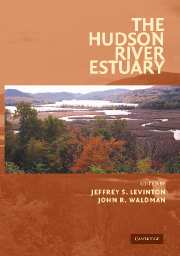Book contents
- Frontmatter
- Contents
- Preface
- List of Contributors
- The Hudson River Estuary
- 1 The Hudson River Estuary: Executive Summary
- GEOLOGICAL, PHYSICAL, AND CHEMICAL SETTING OF THE HUDSON
- PRIMARY PRODUCTION, MICROBIAL DYNAMICS, AND NUTRIENT DYNAMICS OF THE HUDSON
- HUDSON RIVER COMMUNITIES, FOOD WEBS, AND FISHERIES
- 12 Larval Migrations Between the Hudson River Estuary and New York Bight
- 13 The Diadromous Fish Fauna of the Hudson River: Life Histories, Conservation Concerns, and Research Avenues
- 14 Fisheries of the Hudson River Estuary
- 15 The Role of Tributaries in the Biology of Hudson River Fishes
- 16 Ecology of the Hudson River Zooplankton Community
- 17 Submersed Macrophyte Distribution and Function in the Tidal Freshwater Hudson River
- 18 Long-Term and Large-Scale Patterns in the Benthic Communities of New York Harbor
- 19 The Benthic Animal Communities of the Tidal-Freshwater Hudson River Estuary
- 20 Tidal Wetlands of the Hudson River Estuary
- 21 Alien Species in the Hudson River
- CONTAMINANTS AND MANAGEMENT ISSUES OF THE HUDSON RIVER ESTUARY
- Index
- Plate section
- References
15 - The Role of Tributaries in the Biology of Hudson River Fishes
Published online by Cambridge University Press: 06 January 2010
- Frontmatter
- Contents
- Preface
- List of Contributors
- The Hudson River Estuary
- 1 The Hudson River Estuary: Executive Summary
- GEOLOGICAL, PHYSICAL, AND CHEMICAL SETTING OF THE HUDSON
- PRIMARY PRODUCTION, MICROBIAL DYNAMICS, AND NUTRIENT DYNAMICS OF THE HUDSON
- HUDSON RIVER COMMUNITIES, FOOD WEBS, AND FISHERIES
- 12 Larval Migrations Between the Hudson River Estuary and New York Bight
- 13 The Diadromous Fish Fauna of the Hudson River: Life Histories, Conservation Concerns, and Research Avenues
- 14 Fisheries of the Hudson River Estuary
- 15 The Role of Tributaries in the Biology of Hudson River Fishes
- 16 Ecology of the Hudson River Zooplankton Community
- 17 Submersed Macrophyte Distribution and Function in the Tidal Freshwater Hudson River
- 18 Long-Term and Large-Scale Patterns in the Benthic Communities of New York Harbor
- 19 The Benthic Animal Communities of the Tidal-Freshwater Hudson River Estuary
- 20 Tidal Wetlands of the Hudson River Estuary
- 21 Alien Species in the Hudson River
- CONTAMINANTS AND MANAGEMENT ISSUES OF THE HUDSON RIVER ESTUARY
- Index
- Plate section
- References
Summary
abstract The objectives of this chapter are to summarize our observations of fishes in Hudson River tributaries and to document the significance of tributaries to them. Currently alewife is the only anadromous fish that extensively uses Hudson River tributaries. Several potamodromous species depend on tributaries for reproduction (at least smallmouth bass and white sucker) or reproduce in several areas including tributaries (white perch). In many cases, the data available are not adequate to determine how significant tributary spawning is in these species. Young-of-year fishes present in tributary mouths are also abundant in other habitats in the tidal Hudson River, which is also true for those species considered resident in the tributary mouths. Too few tributaries have been examined thoroughly enough to determine whether tributaries are significant for either of these groups of fishes.
Introduction
The tidal Hudson River has at least seventy-nine small to large tributary streams in addition to the Upper Hudson and Mohawk Rivers, which enter the tidal Hudson at the Troy Dam, the upstream limit of tidal influence. There are also an unknown number of smaller, often ephemeral, streams that contribute water to the tidal Hudson River. These tributaries (other than the Upper Hudson/Mohawk) contribute about 20 percent of the freshwater input to the Hudson River (Cooper, Cantelmo, and Newton, 1988). Various researchers have considered these tributaries as sources of important materials such as carbon, sediments (Howarth et al., 1991; Howarth, Schneider, and Swaney, 1996; Swaney, Sherman, and Howarth, 1996), and contaminants (Hirschberg et al., 1996).
- Type
- Chapter
- Information
- The Hudson River Estuary , pp. 205 - 216Publisher: Cambridge University PressPrint publication year: 2006

